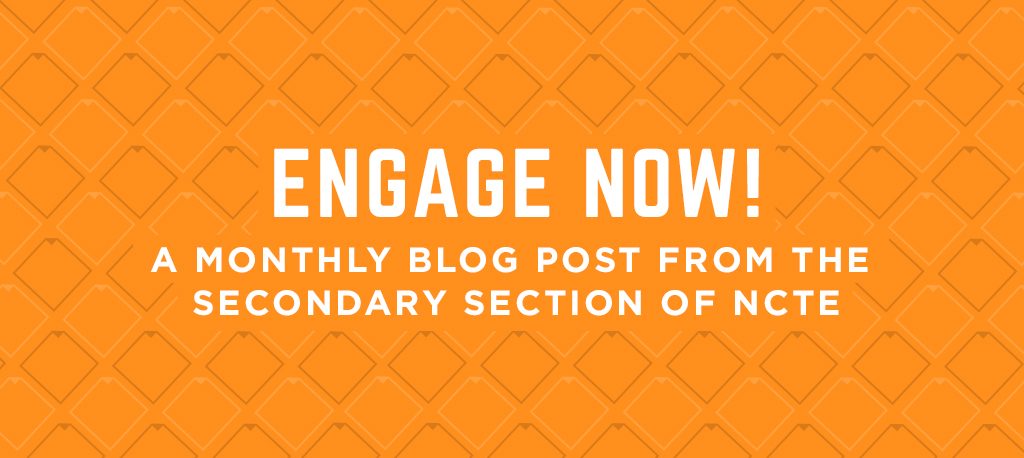
 This blog post was written by NCTE members and Michigan State University secondary English Education student teaching interns Amanda Blay (left) and Carolyn Brown (right).
This blog post was written by NCTE members and Michigan State University secondary English Education student teaching interns Amanda Blay (left) and Carolyn Brown (right).
As student teachers, we have discovered that the texts (including films, music, and television shows) that our students are interested in are not consistently making their way into the classroom. Rather, teachers more often encourage students to read those texts on their own time, and devote class time to teaching the “classics.”
Yet students express less interest in some canonical texts, due, for example, to language or subject matter that is seen as inaccessible. Moreover, many students have trouble connecting to canonical texts that are embedded in the English curriculum. For instance, many culturally and linguistically diverse youth may consider canonical texts less relevant to their lived experiences.
When a teacher incorporates newer texts alongside “classic” texts, this teaching move may help bridge the gap between a novel and a student’s lived experiences. Therefore, we argue that bringing in more contemporary texts to pair with or replace “classic” texts can make the classroom a more exciting and engaging place to learn.
For example, rather than relying on the chance that students connect with some aspect of an assigned text, we recommend showing students a modern adaptation in which the creators engage in the work of relating the text to a new audience. This teaching move allows us to ask ourselves what is valuable in a canonical text, and if those teaching points can be found somewhere else. In most cases, the answer is yes!
Another benefit of bringing in new and diverse content is that doing so shows that the texts students engage with outside of school are valid and can be sites of academic literacy in secondary English teaching and learning. Students who may be focused on grades as indicators of in-school performances may be more open to the idea of reading a young adult novel for fun if they have been exposed to such texts in an academic context. Students who hesitate to read in general may perhaps bring a level of interest if given a more accessible text, including graphic novels.
As mentioned, one way to pair texts is by bringing in modern adaptations. For example, The Lizzie Bennet Diaries on YouTube is a series that follows the same structure of Pride and Prejudice by Jane Austen. Lizzie Bennet is a “vlogger,” which is the case for many of our students’ favorite celebrities. The YouTube series is composed of short three- to five-minute episodes, and is free to access, so it may be readily shown in class during study of the novel. Pairing these texts is one example of a quick way to add a modern twist to an existing curriculum.
Another way to pair texts is to do so by theme. For example, The Crucible by Arthur Miller is a canonical text that has similar themes to the movie Mean Girls. Although the texts take place in very different time periods, they both follow the story of a group of girls who cause trouble in their community by spreading rumors and lies. Themes that are present in both texts are jealousy and reputation.
Rather than having your students just watch or listen to these modern texts, we suggest teachers have students actually engage with them!
For instance, you can find the script to a movie or television show and ask students to engage in a close reading. You can also have students analyze the visual and audio components of the film, then consider how those components convey themes of the story differently than the written word alone. In English education, watching a movie may often be seen as a “cop-out” used when there’s nothing else to do. With pairing texts, that doesn’t have to be the case!
These thoughts took us to our first NCTE Convention — the 2018 Houston Convention — where we presented on text pairings at a roundtable session for student teachers. It was a great opportunity to engage in collaborative work, which was our vision for this initiative. Our plan now is to continue inviting our colleagues and students to compile their favorite text pairings into an accessible online resource.
We currently have a Google document that anyone can edit, which can be found on our Twitter accounts (below), or here.
We invite you to add your own text pairings, or share the link!
Amanda Blay: @amanda_blay
Carolyn Brown: @Carolynbr95
This scholarship was presented as part of the “Future Is Now” session at the 2018 NCTE Annual Convention. For more information about this session for undergraduate and master’s level students, see the session website at <https://nctefutureisnow.weebly.com>.

